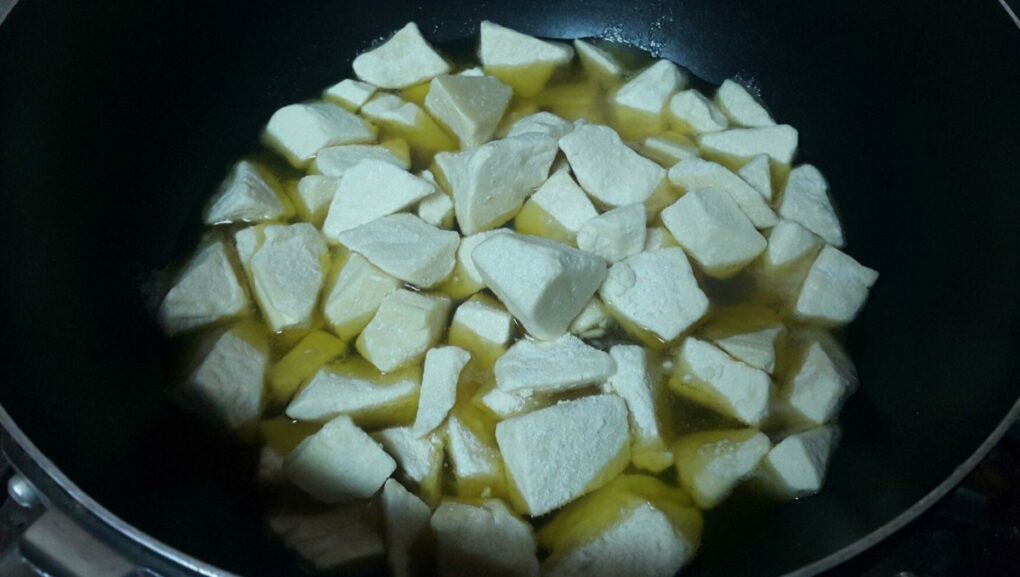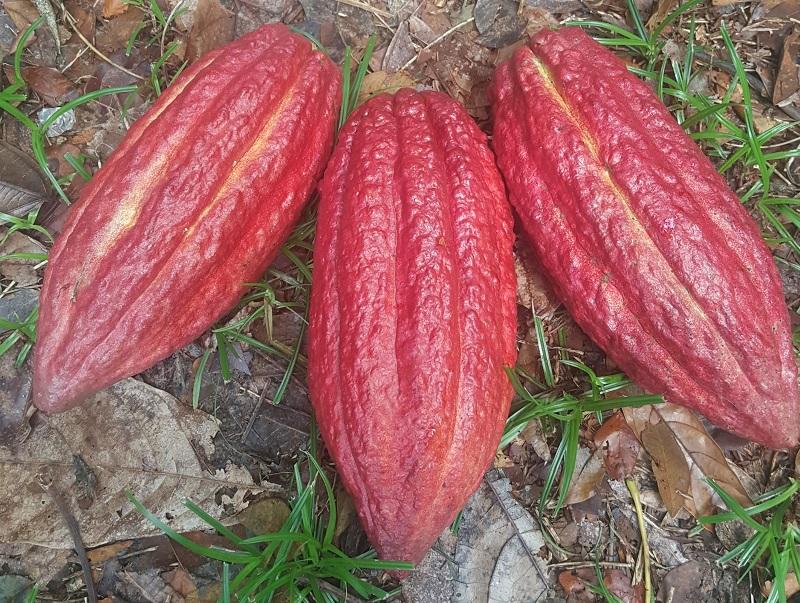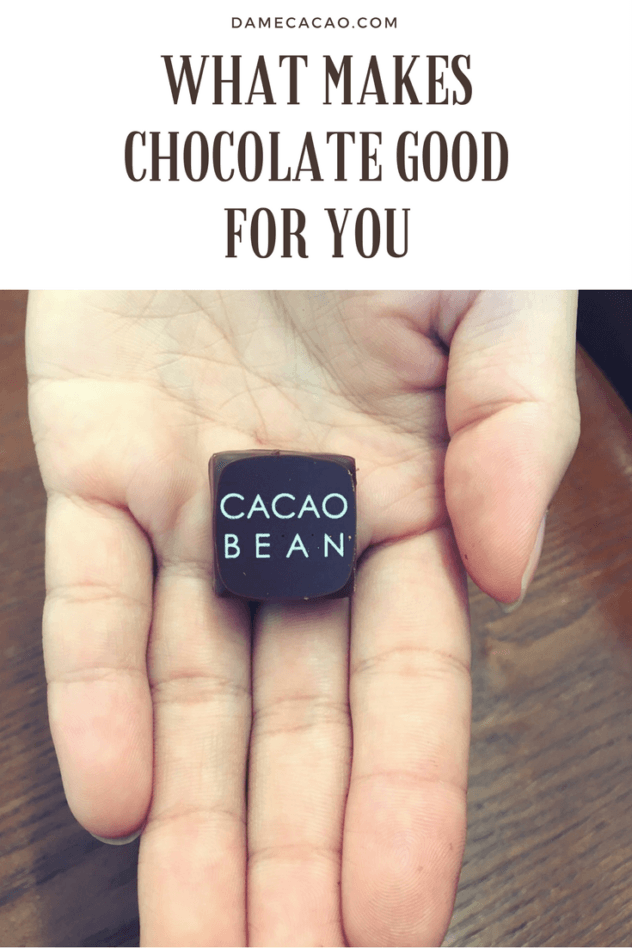Is chocolate dark actually healthy? The buzz around dark chocolate these days is focused on flavonoids and trace minerals, some of the molecules that make cacao a so-called "super food." But do you know what those things are, and more importantly, why they matter?
Chocolate is good for you because it makes you happy on a basic, chemical level. Studies have proven this time & time again, but no, the Hershey's and Cadbury's bars that are half sugar don't count. But a positive brain response is not the only reason to grab a quality chocolate bar for your post-meal bliss.

Jump To
What Is Dark Chocolate?
Many countries have a legal definition for each of the three types of chocolate: white, milk, and dark. These definitions basically regulate the minimum amount of cacao derivatives and dairy which must be present in each chocolate, as well as a "nutritive carbohydrate sweetener" (sugar) content maximum.
For its part, dark chocolate is actually not yet explicitly defined by the FDA, which rather chooses to define the term "chocolate," allowing companies to characterize their chocolate products however they'd like. To speak more specifically about dark chocolates, the main differences between any given darks will be the percentage and the cacao origin.
People commonly ask me 'why is 70 percent dark chocolate best?' and I often respond with a question of my own— what are you using it for? Because whether you're baking, supplementing or just plain enjoying will be the final dictator of which dark chocolate is best for you.
Any chocolate with at least 10% cacao but less than 12% dairy is considered a dark chocolate, and in fact a milk chocolate made with an alternative milk is legally considered dark chocolate. This could mean good news if you're supplementing with dark chocolate for health, but normally find dark chocolate too bitter or strong.
But if you're just looking for the scientific findings to validate your nightly indulgence, then read one to learn what your chosen chocolate can do. There are so many benefits of dark chocolate, most of which are related to the food's trace nutrients and natural antioxidants. But milk and white chocolates share in many of those benefits, as well.

1. Chocolate Fights Ageing
Small amounts of quality chocolate fight the aging process. Cacao, the main ingredient in dark chocolate, is a plant. As such it naturally contains a class of plant-derived antioxidants called flavonoids. Flavanols and polyphenols are two types of flavonoid found in chocolate— as well as red wine and green tea— which fight aging at a cellular level.
The main type of cocoa flavanol is called epicatechin, an antioxidant now commonly used as a supplement in bodybuilding, as it increases blood flow to the muscles and can lower blood pressure. But note that these antioxidants are only found in the cocoa solids, so neither blonde, ruby, nor white chocolate wouldn't have this benefit.
2. Cacao Butter is Good For You
The fat in cacao is good for you, in moderation. Cocoa butter, as the fat of the cacao seed is called, is mostly made up of four types of fatty acids whose combined power has been shown to have an overall neutral effect on the heart. The distribution is such that about 75% of the fatty acids which make up cocoa butter are actually protective of the heart.
But that other pesky 25% (I'm looking at you palmitic acid) can have a huge impact on its own, even contributing to heart disease if consumed in very large amounts. Chocolate itself is still high in calories, so keep your treats small.

3. Chocolate Fights Poverty
When chosen discerningly, chocolate raises people out of poverty. Millions of cacao farmers around the world depend upon consistent income from the humble cacao bean. To combat the poverty built into the system, many chocolate makers create supportive direct relationships with farmers & their farms, raising prices and quality. While this may not cover every single moment that the cacao is in transit, it's a huge step in the right direction.
4. Cacao Maintains Global Biodiversity
Cacao trees help to maintain biodiversity on plantations. Increased diversity helps cacao thrive, improving the quality of cacao grown— and therefore the chocolate made— around the world. With various crops ready for market at different times, farmers can maintain consistent income, making it more likely that they will harvest cacao only when it is ripe.
5. Cacao Teaches You About Globalism
Sustainable chocolate teaches you about other cultures. Cacao is now grown on farms in Taiwan and the US, Uganda and Cuba, with industry-wide plans under way to continue sustainably expanding growing regions. Knowing where the ingredients come from and how chocolate is made is the first step towards understanding our global interdependence, and how it affects other cultures.

Cacao on a Chemical Level
Understanding cacao and chocolate on a chemical level is so complex that we still don't have the whole picture. Scientists have found hundreds of substances in cacao which contribute to the unique flavor notes and health benefits attributed to cacao. Many of these health benefits are due to the fact that cacao is a plant, grown in the tropical rain forests of the Americas for millennia.
It would take hours to provide a thorough overview of the chemistry of cacao's 600+ compounds, so here we stick to the basics. Flavonoids— in the form of flavanols and polyphenols, among others— are antioxidants present in chocolate, good for us because they have been shown to slow the damaging effects which oxygen can have upon our cells.
Think of a slice of apple left out in the open air for an hour; that's similar to what's slowly happening to our cells. Trace minerals which your body needs to function, such as calcium, magnesium, and phosphorus, are also present in cacao.

Small amounts of caffeine and larger amounts of theobromine, a chemical closely related to caffeine and with similar effects, account for the energizing properties associated with chocolate. Ten distinct varietals of cacao are currently known to exist, but they are often referred to as criollo, trinitario, forastero, and nacional.
Each varietal of cacao carries a distinct nutritional potential, thanks to genetic variation, growing location, and amount of sunlight, among others. For reference, any given cocoa bean is generally composed of about half fat, in turn made up of stearic, palmitic, linoleic, and oleic fatty acids (palmitic acid is the unhealthy one).
But even the exact percentage of fat, and the proportions of these saturated & unsaturated fats, varies between varietals. Distance from the equator plays a huge role, but how much of these nutrients remain intact once the cacao becomes chocolate depends on its processing on the farm & in the chocolate factory.

Other Ingredients in Chocolate
Once cacao arrives in the hands of a chocolate maker, it is generally in the form of unroasted cacao beans. This is the most essential ingredient in chocolates of all types. After arrival, these beans are cleaned, roasted, and the shells removed. Roasting the 'beans' at a lower temperature over a longer period of time can preserve more of cacao's nutrients.
However, this tends to preserve the uniqueness of the beans' flavor, leading to inconsistent flavor in products, something which chocolate manufacturers don't value. Additionally, roasting at higher temperatures brings out a more chocolaty flavor, as does "dutch processing," a common way to standardize flavor.
To "dutch process" cacao or cocoa powder is to alkalize the acidic cacao. This neutralizes pH and heightens the traditional cocoa flavor, while lowering bio-availability of nutrients. Milk proteins are also believed to bind themselves to the nutrients in cacao and make them less bio-available, albeit with less negative impact compared to dutching.

A modern approach to this issue is the use of alternative fat sources, which must be powdered in order to maintain low moisture in chocolate. Milk traditionally dulls the bitterness and astringency, as well as the more positive flavors, found in cocoa.
Some cheap replacements for cocoa butter are PGPR, and palm and vegetable oils. But some alternatives rising in popularity are coconut milk powder and heavy cream powder. It is still unknown how these milk substitutes affect chocolate on a chemical level, but the flavor results seem positive.
Sugar is the most common addition to cocoa in order to create healthy chocolate that's also palatable; in broader society it's also seen as the most agreeable. Added sugar satisfies our sweet expectations, allowing dark chocolate lovers to focus on the unique flavors inherent in a chocolate. But beyond this, it spikes blood sugar, causes weight gain, and coerces you into eating more in one sitting.
Alternative sugars are here and they are loud & proud, primarily in terms of flavor. Raw cane sugar and coconut sugar are the more nutrient-dense, but flavorful options. Alternative sweeteners stevia, maltitol, and xylitol carry their own downsides, the most obvious being the loss of sugar's bulk. Each option creates a different chocolate experience, and it's your responsibility not to outsource your health in hopes of a quick fix.

Best Chocolates for the Body & Soul
Every chocolate bar is a promise to you, the consumer. Some makers are better at following through on that promise while sourcing ingredients, crafting bars, and marketing products. But seeing through the noise can be tough. Transparency in the value chain must be offered in order to bring better chocolate and more global equality to the table.
Which chocolates on the current market are best for your health is even tougher to say. Just like a bottle of beer from the supermarket doesn't say what varieties of hops or grains were used or how long everything was fermented, ect., your bar of chocolate won't say absolutely everything. And to say which chocolate bar is unequivocally most healthy, you need to know everything.
Luckily there are some clues that can tell you which chocolates are healthier, starting with the quality of the cacao. Look for "single origin" and "bean to bar chocolate," and don't be intimidated by higher percentages or price tags. You're finally paying for cacao rather than sugar. Lower roast profiles and cacao said to be of the criollo or trinitario varieties will result in more intact nutritional value and better flavor.
Try consuming dark chocolate, or a high percentage milk chocolate without dairy. You don't have to add so-called super foods to chocolate to make it healthy. We just learned that cacao is inherently healthy, but the processes it often undergoes & the ingredients added are often not. However, your chocolate habit is not about to disappear. So form a relationship with a chocolate brand.
Get to know their best practices and what makes their chocolate unique and worthy of your purchasing power. Remember that where you spend your money makes a difference. Positive reinforcement of positive practices will lead to more quality chocolate consumption and more satisfaction on every front. My advice? Always eat with intention.

Chocolate FAQ!
Unsweetened chocolate liquor (ground cacao nibs) and sugar. Some chocolate companies also add vanilla, extra cocoa butter, and/or an emulsifier, while larger manufacturers are known to add other vegetable oils, flavorings, and preservatives.
A high cocoa content dark chocolate bar contains lots of potassium, which can help ease period cramps, and the moderate amount of sweetener helps raise overall "feel good" chemicals in the body without overloading on inflammatory sugar. The better question here is ‘can dark chocolate be bad for you?’ in general, and the answer is yes. If you're on your period, avoid white chocolates and low percentage/low quality milk and dark chocolates.
Some people ask me ‘why is 70 percent dark chocolate best for you?’ and I always tell them that this is an imprecise aphorism— the best chocolate is the highest percentage dark chocolate you really enjoy eating. But for some people that will be a 55% dark and for others a 95% dark. That’s a massive jump, but the most important part is high quality cacao & the more of that you happily eat, the better for you.
A simple answer is 28g (1oz.) per day. But choosing exactly what dark chocolate is good for you to eat each day is less simple, as quality and quantity play equal roles. If you’re eating a low percentage, low quality milk chocolate, it's only going to contain around 30% cacao, most of it composed of cacao butter. That means that nearly all the flavanols protecting you from cardiovascular disease and cell ageing are functionally absent, increasing your LDL cholesterol with nothing to balance the scales. Always pick a high percentage dark chocolate, preferably craft chocolate.
A good quality dark chocolate with at least 70% cacao is good for the heart in moderation, around 28g (1oz.) per day. If you crave more chocolate, I suggest trying a chocolate-covered treat like almonds. But are dark chocolate almonds good for you to eat every day? Sure! Just don't have more than 2oz. (or even less if your body is generally sensitive to saturated fat).
The cacao solids in the chocolate do contain a small amount of caffeine and moderate amounts of theobromine, an alkaloid similar to caffeine. So if you have insomnia and a caffeine sensitivity, is it bad to eat dark chocolate every day before bed? It’s probably not good. If you think chocolate may be affecting your sleep or you have have a histamine issue, limit your chocolate intake to less than 1oz. per day & only in the mornings.
Thanks to natural antioxidants, very high percentage dark chocolate may have moderately protective properties for your skin, but it's the highly inflammatory sugar that'll get you. This is also tied to whether or not chocolate is good for gut health, as high-sugar chocolates tend to have negative consequences for the gut, the heart, and your BMI. If you're worried about your skin or gut, stick to higher-percentage milk and dark chocolates.
Learned something about what makes dark chocolate good for you? Pin it & share it!


















Stu
Thank You for sharing this helpful blog, I always love your way of putting things.
Max
Thanks, Stu!
john
This article is very good about dark chocolate. Chocolate-based recipes such as fudge or brownies are just as essential in providing healthy fat as chocolate is, with obvious moderation.
Max
Thank you, John! Glad to hear you agree that chocolate can be a part of a healthy diet; it's all about moderation!
Canem Divit
Cacao, the plant that produces chocolate, is rich in minerals and antioxidants. Commercial milk chocolate includes sugar, cocoa butter, milk, and a small percentage of cacao. Contrary to milk chocolate, dark chocolate contains a much higher amount of cacao and less sugar. According to the market database, dark chocolate manufacturers continue incorporating organic ingredients and natural sweeteners to support the health & wellness trend. The health benefits of dark chocolate continue to set it apart from milk chocolates.
Max
I agree.
Kim
I was pretty certain about the health benefits of Dark chocolate, but never know anything about the nutritional values of cacao. This is really helpful. Thanks.
Max
You're very welcome! I'm glad you found it helpful. 🙂
Thomas Forbes
Fantastic article. I’ve never read that different varietals of cacao have different nutritional values. Is the range that big a difference? Your articles are very good.
Max
Thank you, Thomas! Cacao butter percentage alone can vary up to 5-7%, depending on origin. I believe the range is understandably most different between the ten genetic families, but most cacao is a blend of genetics from those ten, so selecting any very specific strain for its nutritional value would be quite difficult (if not impossible, with cross-pollination amongst trees). You'd have to test each individual pod's seeds for the amount of each of the hundreds of compounds in cacao, and then you'd still be extrapolating that the rest of the pods in that area would have the exact same balance of compounds. It's easier to test the finished chocolate itself, but even that gets costly and can vary between batches. This is why we still— and probably for a long time will continue to— speak about chocolate more generically (dark/milk/white + cacao percentage).
I appreciate the thoughtful question!
Lloyd Bronson
I am glad that in your article you mentioned that the fat in cocoa is good in moderation. For many people, eating simply chocolate lacks any sort of diversity and as a result, they likely never eat chocolate as it is too boring. Chocolate based recipes such as fudge or brownies are just as essential in providing healthy fat as chocolate is, with obvious moderation.
Max
Yeah, unfortunately those recipes are also super high in sugar, which doesn't negate the healthy properties in chocolate, but it certainly doesn't add anything to them! But as you said, most anything is fine in moderation.